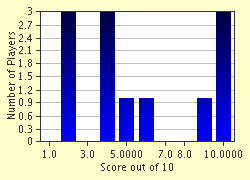Quiz Answer Key and Fun Facts
1. "One Night: Ultimate Werewolf" is billed as a game that can accommodate three to ten players. The players are characters in a village, and each player gets a role at random. To keep people guessing, not all roles are used. After each player has taken a role, how many unused roles should be left in the centre of the table?
2. The players are all playing as inhabitants of a village beset by werewolves. The villagers try to determine who the werewolves are, while the werewolves try to obscure the information, and direct suspicion at the villagers. One role is called the Minion, who is actually a villager trying to help the Werewolves win. Do the Werewolves know who the Minion is?
3. "One Night: Ultimate Werewolf" is primarily a game about villagers against werewolves. There is a third faction, though, that has its own agenda. Which single role is on neither the werewolf team, nor the villager team?
4. "One Night: Ultimate Werewolf" has two phases: the night phase, and the day phase. During the night phase, players will "wake up" in a certain order, and perform specific actions according to their roles. Some roles, however, are never called to wake up at all, and have to trust what the other players say during the day phase. Out of the following roles, which one DOES wake up during the night phase?
5. In "One Night: Ultimate Werewolf", an important part of figuring out who is who is by looking at other players' roles. Players can use this information to catch other players' lies, or set up their own deceptions. Of the following roles, which one CANNOT look at another player's role?
6. The chaos of "One Night: Ultimate Werewolf" really picks up when people stop being who they think they are. Some roles let players swap roles; sometimes their own, and sometimes those of other players. Of the following, which role CANNOT change any player roles?
7. In "One Night: Ultimate Werewolf", the different roles wake up in a specific order. This is important when trying to figure out what sequence of events occurred during the night phase. Out of the following roles, which one wakes up first?
8. In "One Night: Ultimate Werewolf", most of the information gathering roles wake up first. The roles that change the roles players have, and generally cause chaos, wake up after. Out of the following roles, which one wakes up last?
9. Most of the roles in "One Night: Ultimate Werewolf" are unique, but some come with duplicates. There are two Werewolf role tiles, two Masons, and three Villagers. Is it appropriate to play a game using only a single Mason?
10. During the day phase, player discuss with each other, and try to figure out what transpired during the night (or obscure that information). At the end of the day phase, each player will vote, simultaneously, to kill a different player. The player with the most votes is then killed, and everyone flips over their roles to see who won and who lost. The villagers win if a Werewolf is killed, while the Werewolves win as long as none of them die. Is it possible that no players have a Werewolf role?
Source: Author
qrayx
This quiz was reviewed by FunTrivia editor
WesleyCrusher before going online.
Any errors found in FunTrivia content are routinely corrected through our feedback system.

